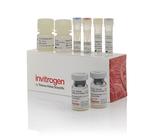Search Thermo Fisher Scientific
图: 1 / 4
Human IL-21 Proquantum Immunoassay Kit




产品规格
检测灵敏度
测定范围
检测样本类型/体积
手工操作时间
总时间
均相(无需洗涤)
检测仪器
产品规格
产品成分
Antibody-Conjugate A
Antibody-Conjugate B
Antibody-Conjugate Dilution Buffer
Standard
Master Mix
Ligase
运输条件
储存
蛋白名称
均相(无需洗涤)
检测试剂盒格式
标签或染料
关于本试剂盒
The ProQuantum Human IL-21 Immunoassay Kit is designed to provide quantitative measurements of human IL-21 in small sample volumes. Utilizing proximity-based amplification technology, the assay combines the analyte specificity of high-affinity antibody-antigen binding with the signal detection and amplification capabilities of real-time PCR to achieve a simple yet powerful next-generation protein quantitation platform. A user-friendly workflow combined with intuitive software for analytics enables sample-to-answer in just 2 hours.
• High sensitivity-detect low levels of protein with greater sensitivity than traditional methods
• Broad dynamic range-5 logarithmic units, minimizing sample dilutions to ensure they fall within the range
• Small sample consumption-use 2-5 µL of sample (compared to 75 µL for triplicate wells with other methods)
• Fast, easy workflow-2 hours from sample to answer, with no wash steps
• No proprietary instrument to purchase-runs on any real-time PCR instrument
ProQuantum immunoassays utilize a matched pair of target-specific antibodies, each conjugated to a DNA oligonucleotide. During antibody-analyte binding, the two DNA oligos are brought into close proximity, which allows for ligation of the two strands and subsequent creation of a template strand for amplification. This platform leverages the sensitivity and large dynamic range of Applied Biosystems TaqMan real-time PCR technology (Figure 1).
The assay workflow is fast and easy-2 steps in 2 hours. There are a total of 7 components in each kit (Figure 2). First, mix the antibody-conjugates, dilute the sample, and create the standard curve in a working plate. Then, using a multi-channel pipette, add the antibody-conjugates and sample (or standard) into the wells of a PCR plate and incubate for 1 hour. Combine the master mix and ligase and add to the wells of the PCR plate, then run the plate on any qPCR instrument. After the run is complete, import the results file into the ProQuantum software (cloud-based version at https://apps.thermofisher.com/apps/proquantum). Using this software, the data can be analyzed easily to obtain protein concentration values. The software allows you to set up standard curves, design plate layouts, apply a 5PL weighted algorithm, and obtain robust statistical group-wise comparisons.
IL-21 is a 17 kDa immunomodulatory cytokine produced mainly by Natural Killer Cells (NKT), T helper (Th) 17 and T follicular helper (TFH) cells. In TFH cells, IL-21 expression leads to autocrine signaling through the IL-21 receptor (IL-21R) and STAT3, which leads to additional transcriptional activation by Bcl6. As with IFN gamma for Th1 and IL-4 for Th2 cells, IL-21 is critical for TFH cell development and effector function. IL-21 plays a role in T cell-dependent B cell differentiation into plasma cells and memory cells, stimulation of IgG production and induction of apoptotic signaling in naive B cells. In Th17 cells, IL-21 expression and autocrine feedback through STAT3, IRF4 and ROR gamma t lead to upregulation of the IL-23R, thereby preparing Th17 cells for maturation and maintenance by the inflammatory cytokine IL-23. While upregulating IRF4 and ROR gamma t, IL-21 also mediates the downregulation of Foxp3. IL-21 deficient mice are protected from developing colitis upon chemical treatment by their inability to upregulate Th17-associated molecules. In comparison, elevated levels of IL-21 are present in chemically-induced colitis mouse models.
仅用于科研。不用于诊断过程。未经明确授权不得转售。
篇参考文献 (0)
生物信息学
基因别名 : CVID11, IL-21, IL21, Za11
基因ID : (Human) 59067
基因符号 : IL21
蛋白别名 : IL-21, Interleukin-21, interleukin-21 isoform, Za11
UniProt ID (Human) Q9HBE4


